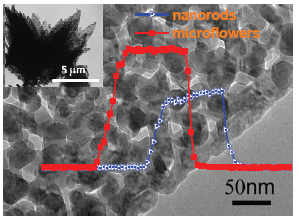| [1] Huang, M. H.; Mao, S.; Feick, H.; Yan, H. Q.; Wu, Y. Y.; Kind, H.; Weber, E.; Russo, R.; Yang, P. D. Science 2001, 292, 1897.[2] Wang, Z. L.; Song, J. H. Science 2006, 312, 242.[3] Wang, Z. L. Adv. Mater. 2012, 24, 4632.[4] Law, M.; Greene, L. E.; Johnson, J. C.; Saykally, R. J.; Yang, P. D. Nat. Mater. 2005, 4, 455.[5] Gao, T.; Wang, T. H. Appl. Phys. A 2005, 80, 1451.[6] Feng, X. J.; Feng, L.; Jin, M. H.; Zhai, J.; Jiang, L.; Zhu, D. B. J. Am. Chem. Soc. 2004, 126, 62.[7] Vayssieres, L. Adv. Mater. 2003, 15, 464.[8] Arnold, M. S.; Avouris, P.; Pan, Z. W.; Wang, Z. L. J. Phys. Chem. B 2003, 107, 659.[9] Kuo, C. L.; Kuo, T. J.; Huang, M. H. J. Phys. Chem. B 2005, 109, 20115.[10] Li, J.; Fan, H.; Jia, X. J. Phys. Chem. C 2010, 114, 14684.[11] Greene, L. E.; Law, M.; Goldberger, J.; Kim, F.; Johnson, J. C.; Zhang, Y. F.; Saykally, R. J.; Yang, P. D. Angew. Chem., Int. Ed. 2003, 42, 3031.[12] Pan, Z. W.; Dai, Z. R.; Wang, Z. L. Science 2001, 291, 1947.[13] Zheng, J. H.; Zhang, X. K.; Lu, H. F. Acta Chim. Sinica 2011, 69, 2434. (郑建华, 张晓凯, 卢慧粉, 化学学报, 2011, 69, 2434.)[14] Bai, H. Y.; Bao, J. C.; Dai, Z. H.; Liu, K. Acta Chim. Sinica 2008, 66, 1786. (白红艳, 包建春, 戴志晖, 刘可, 化学学报, 2008, 66, 1786.) [15] Zhang, N.; Yu, K.; Li, Q.; Zhu, Z. Q.; Wan, Q. J. Appl. Phys. 2008, 103, 104305.[16] Son, J. Y.; Lim, S. J.; Cho, J. H.; Seong, W. K.; Kim, H. Appl. Phys. Lett. 2008, 93, 053109.[17] Law J. B. K.; Thong, J. T. L. Nanotechnology 2008, 19, 205502.[18] Jing, Z. H.; Zhan, J. H. Adv. Mater. 2008, 20, 4547.[19] Zuruzi, A. S.; MacDonald, N. C.; Moskovits, M.; Kolmakov, A. Angew. Chem., Int. Ed. 2007, 46, 4298.[20] Chen, M.; Wang, Z.; Han, D.; Gu, F.; Guo, G. J. Phys. Chem. C 2011, 115, 12763.[21] Zhang, H.; Wu, J. B.; Zhai, C. X.; Du, N.; Ma, X. Y.; Yang, D. R. Nanotechnology 2007, 18, 455604.[22] Lee, J. H. Sens. Actuators, B 2009, 140, 319.[23] Fu, M.; Zhou, J.; Xiao, Q. F.; Li, B.; Zong, R. L.; Chen, W.; Zhang, J. Adv. Mater. 2006, 18, 1001.[24] Ding, G. Q.; Shen, W. Z.; Zheng, M. J.; Fan, D. H. Appl. Phys. Lett. 2006, 88, 103106.[25] Zhang, W. X.; Yanagisawa, K. Chem. Mater. 2007, 19, 2329.[26] Song, R. Q.; Xu, A. W.; Deng, B.; Chen, G. Y. Adv. Funct. Mater. 2007, 17, 296.[27] Gui, Z.; Liu, J.; Wang, Z. Z.; Song, L.; Hu, Y.; Fan, W. C.; Chen, D. Y. J. Phys. Chem. B 2005, 109, 1113.[28] Xiong, J. F.; Shen, H.; Mao, J. X.; Qin, X. T.; Xiao, P.; Wang, X. Z.; Wu, Q.; Hu, Z. J. Mater. Chem. 2012, 22, 11927.[29] Korotcenkov, G.; Han, S. D.; Cho, B. K.; Brinzari, V. Critical Rev. Solid State Mater. Sci. 2009, 34, 1.[30] Waitz, T.; Becker, B.; Wagner, T.; Sauerwald, T.; Kohl, C. D.; Tiemann, M. Sens. Actuators, B 2010, 150, 788.[31] Wu, Q.; Chen, J. X.; Zhang, F.; Xiao, P.; Lu, Y. N.; Wang, X. Z.; Hu, Z. CrystEngComm 2012, 14, 3397.[32] Liu, J. F.; Wang, X.; Peng, Q.; Li, Y. D. Adv. Mater. 2005, 17, 764.[33] Wang, J. X.; Sun, X. W.; Yang, Y.; Huang, H.; Lee, Y. C.; Tan, O. K.; Vayssieres, L. Nanotechnology 2006, 17, 4995.[34] Wang, X. Z.; Liu, W.; Liu, J. R.; Wang, F. L.; Kong, J.; Qiu, S.; He, C. Z.; Luan, L. Q. ACS Appl. Mater. Interfaces 2012, 4, 817.[35] Wang, L. W.; Kang, Y. F.; Liu, X. H.; Zhang, S. M.; Huang, W. P.; Wang, S. R. Sens. Actuators, B 2012, 20, 237.[36] Chen, J.; Li, J.; Li, J. H.; Xiao, G. Q.; Yang, X. F. J. Alloys Compd. 2011, 509, 740.[37] Ahn, H.; Park, J. H.; Kim, S. B.; Jee, S. H.; Yoon, Y. S.; Kim, D. J. Electrochem. Solid-State Lett. 2010, 13, J125.[38] Zhang, Z. Y.; Li, X. H.; Wang, C. H.; Wei, L. M.; Liu, Y. C.; Shao, C. L. J. Phys. Chem. C 2009, 113, 19397.[39] Zhang, J.; Wang, S. R.; Xu, M. J.; Wang, Y.; Zhu, B. L.; Zhang, S. M.; Huang, W. P.; Wu, S. H. Cryst. Growth Des. 2009, 9, 3532.[40] Wan, Q.; Li, Q. H.; Chen, Y. J.; Wang, Y. H.; He, X. L.; Li, J. P.; Lin, C. L. Appl. Phys. Lett. 2004, 84, 3654. |
